We go to the hospital when we feel sick.
This obvious, almost natural way in which we currently think about medical care may change completely by 2045. At the Center of Innovation (COI) program's Center of Open Innovation Network for Smart Health, researchers are working to develop microscopic capsule nanomachines containing various sensors and drugs that can travel to all parts of the body through the blood. These devices may help establish a new type of medicine that can detect and treat diseases at very early stages. The researchers aim to realize a society in which individuals are free from the physical and economic burden and anxiety associated with serious illness--a society in which everyone can enjoy guaranteed health.
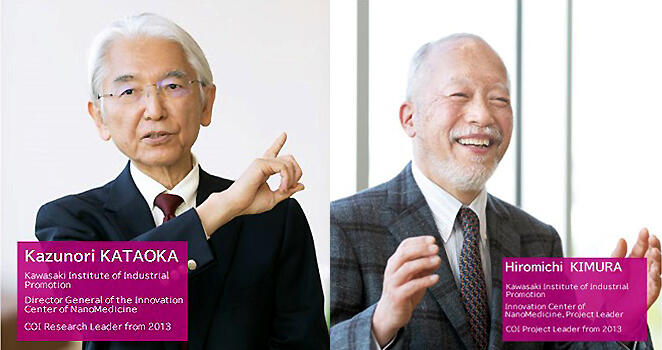
Contributing to the Fulfillment of a Healthy Life: "In-Body Hospitals" by 2045
In a super-aged society, most individuals hope to achieve an independent "healthy life span" without suffering a major illness or requiring support or nursing care. Currently, the leading causes of death among Japanese people are cancer, heart diseases, and cerebrovascular diseases. Although improved treatments are being established, the anxiety of hospitalization and the high cost of medical care associated with treatment are obvious concerns. Furthermore, a substantial number of people visit hospitals for long durations owing to lifestyle-related diseases and continue treatment through medication. As medical treatments become increasingly sophisticated, rising medical expenditures is becoming a social problem, putting a strain on people's wallets.
The Center for Open Innovation Network for Smart Health (COINS), which aims to lead the transformation to a smart life care society, is working on developing marvelous, futuristic techniques to solve these issues. The Project Leader Hiromichi Kimura at the Innovation Center of Nanomedicine (iCONM) had the following to say regarding the ideology behind COINS. "Small hospital-like entities will travel throughout your body, looking to detect and treat signs of illness at very early stages (Figure 1). While this might sound like science fiction, our research hopes to realize these" in-body hospitals "by 2045." In other words, the researchers are trying to realize the sort of world depicted in the 1960s-era movie "Fantastic Voyage."
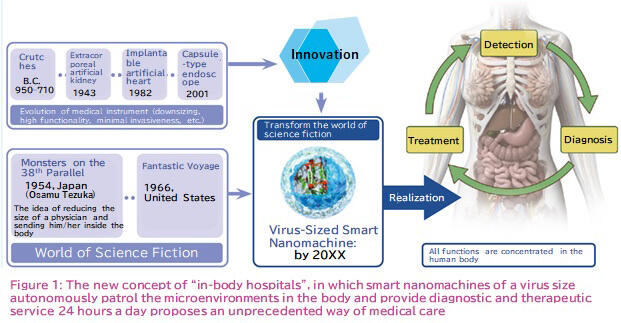
It is almost impossible to ensure that no one will ever have any disease. However, if diseases can be detected and treated at an early stage, even before a person is even able to notice them. Patients will spend very little time feeling ill and will instead be able to enjoy their lives more comfortably. "If in-body hospitals are realized, we will be freed from the burdens of cost and time spent on illness and treatment. There will be no anxiety about what will happen if we were to suddenly fall ill," said the iCONM Director General Kazunori Kataoka. In-body hospitals will support preventive and home healthcare and telemedicine in areas where hospitals are not in the vicinity, and everyone will be able to live in a society where they can independently obtain healthcare daily. It is expected to become a new approach to healthcare.
Applications to Cancer Therapy are Imminent
Accumulation in Tumor Tissues
In-body hospitals will be realized through nanomachines, which are polymeric capsules approximately 50 nm in diameter (A nanometer is one-billionth of a meter) (Figure 2). These capsules will comprise sensors and medications for diseases; they can truly be compared to small hospitals. Nanomachines that are approximately the same size as viruses enter the body by injection and circulate through the blood vessels to check for abnormalities. Ultimately, the researchers are aiming for a life in which we remain almost unaware of our own illnesses, as even a slight cold is quickly detected and automatically treated. However, a particularly important target is diseases that cause serious symptoms, such as intractable cancer and brain disease.
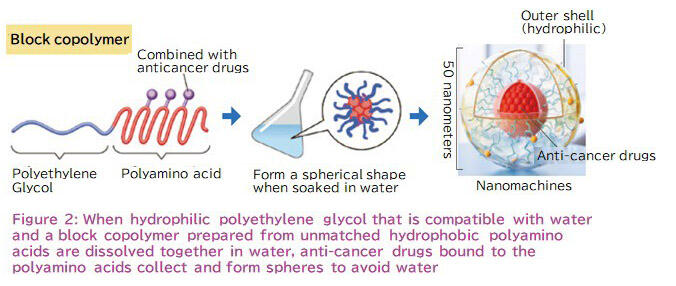
Some nanomachines are very close to practical applications. For example, nanomachines loaded with anticancer drugs that have molecules on the surface of the capsule with the ability to recognize and accurately detect cancer cells. Cancer cells are also more acidic than normal cells. The combination of the capsule polymers and anticancer drugs is designed to break off in cancer cells, automatically releasing the anticancer drugs. The size of nanomachines, i.e., 50 nm, is also an important factor in their design. These nanomachines cannot pass through the walls of blood vessels in normal tissues; however, tumor tissues, such as cancer cells, have undeveloped walls that allow the nanomachines to enter. (Figure 3). These nanomachines cannot pass through the walls of blood vessels in normal tissues; however, tumor tissues, such as cancer cells, have undeveloped walls that allow the nanomachines to enter. (Figure 3). Because lymphatic vessels, which are responsible for efflux, are also underdeveloped in cancer cells, the nanomachines that enter the cancer cells can accumulate without being excreted. This accumulation enables effective treatment with small amounts of drugs.

Nanomachines can be used to treat areas that cannot be operated on; moreover, hospitalization is not required. There is also no concern that they would affect normal cells. "I believe that we will be able to treat diseases, while continuing normal life and work, and lower the cost of treatment," said Dr. Kataoka. He envisages practical application.
There is a global interest in developing messenger RNA (mRNA)-based drugs and vaccines that can be delivered to the brain.
Nanomachines for neurological diseases are being researched for practical use, mainly by the University of Tokyo and Braizon Therapeutics (Bunkyo-ku, Tokyo), which is a venture company spun off from COINS. The brain has a protective barrier called the "blood-brain barrier," which often prevents drugs from being properly delivered to the target site. Thus, effective treatments for many neurological diseases have not yet been fully established. Inventions by COINS have succeeded in penetrating the blood-brain barrier through devising ingenious surface structures on the drug-containing nanomachines. Consequently, it has become possible to deliver the drug to nerve cells in the brain. This breakthrough has been recognized worldwide. It may lead to innovative treatment and diagnosis.
Since the beginning of the project, studies have been conducted on nanomachines that serve as therapeutic agents and vaccines. A particular focus has been on mRNA loaded nanomachines. Genetic information on DNA is usually copied to an mRNA to produce a protein. This can be used as a drug; an external mRNA can be administered to produce a target protein. "Based on research to date, we are also working on the development of a preventive vaccine for the new coronavirus infections. If we can load mRNA, which is unstable in the body, into nanomachines, it is highly likely to be delivered directly to the target cells," said Dr. Kataoka with confidence.
Thus, there are several parallel topics in COINS for practical use (Figure 4). If nanomachines can be devised to remain only inside the knee joint, they may aid in fundamental treatments for age-related gait disturbances. In addition, efforts will be made for developing "cancer diagnostic devices" that are packaged to perform various functions from isolation and purification to the detection of short microRNAs (miRNA) in blood-borne sequences, combining nanomachines with medical devices such as ultrasound irradiators, and establishing therapies that reduce burden on the patient (Figures 5 and 6).
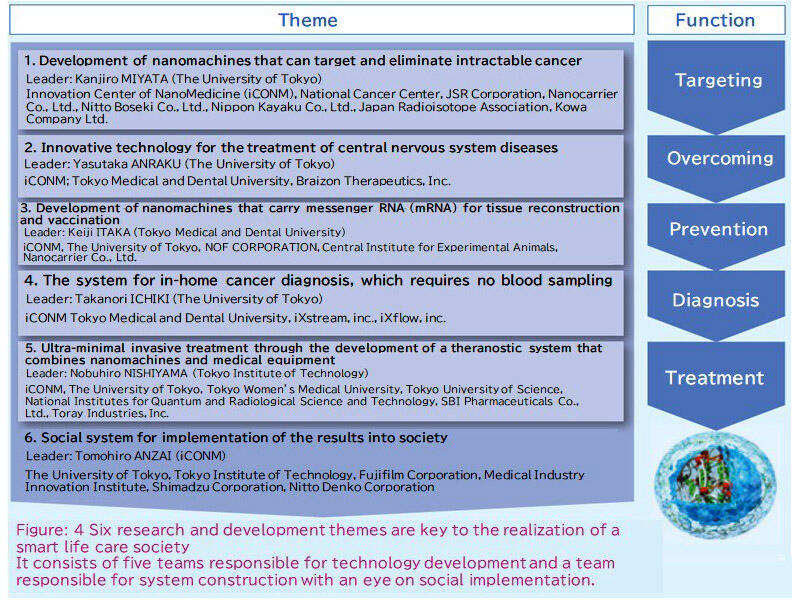
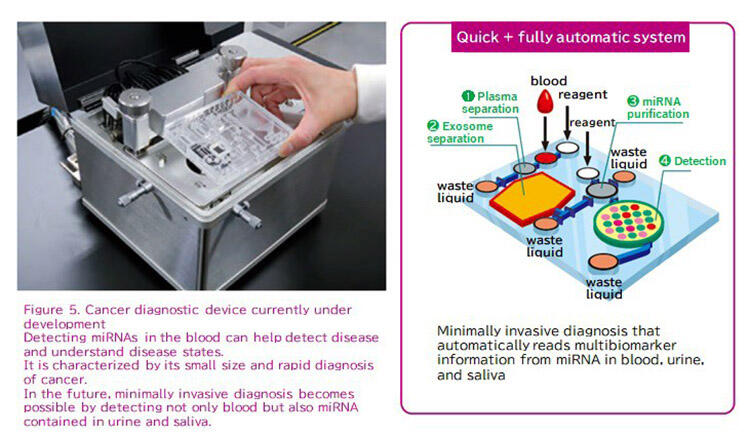
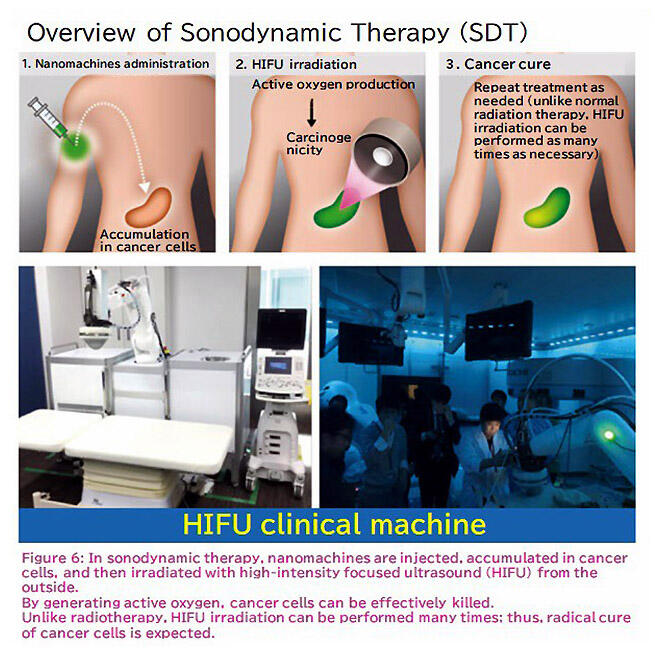
A facility that supports the shared vision of the future we are aiming for
For projects with challenging research themes, it is essential to foster a system that continuously creates innovation by promoting interdisciplinary fusion and collaboration between different industries. "One of the characteristics of COINS is that people are relatively free to participate in, or withdraw from, projects based on certain rules," Dr. Kimura emphasizes. "I believe this is a new approach considering the fact that planning changes tend to be minimized in typical national projects."
In state-of-the-art research, unexpected events occur multiple times before a goal is achieved. Therefore, it is indispensable to have a bold stance on tasks such as gathering human resources, technologies, and knowledge that can contribute to immediate global challenges, and shift to a system that can contribute to the next problem once the first issue is solved (Figure 7). "Because the vision of the future is well defined and shared by all members, it is possible to make rational reviews and substitutions," Dr. Kataoka said. "Some members have seriously considered how they can contribute to society by engaging in COINS and have clarified their research topics." Their penchant for ingenuity aimed at continuously generating innovation can be seen even in the design of their research environment. Their research headquarters, i.e., the Innovation Center of NanoMedicine, is located along the Tama River, where Haneda Airport can be seen on the opposite bank and has a total floor area of 9,400 square meters. The four-story building is divided into functional areas such as a biochemical experiment area and an organic synthesis experiment area on each floor. Structures where comprehensive study and research can be done within a single building form the basis for efficient and effective advancement of projects. Communication spaces--called Magnet Areas--are located at the center of the building to naturally generate interactions between collaborating universities, research institutions, and researchers at companies. Researchers with different affiliations and fields gather; multidisciplinary study sessions are held frequently. "If a variety of researchers stimulate each other in an open environment and many breakthroughs arise, practical application will accelerate," said Dr. Kataoka with a smile.
Under the leadership of Dr. Kimura, who has a wealth of experience in managing global companies and venture capital, iCONM is also very active in establishing venture companies and new businesses. Participating researchers can acquire not only research experience but also management skills by establishing a network with intellectual property, financing, and legal experts. It can be seen clearly that this is a place of learning beyond just research, but one with a clear purpose. These efforts were recognized as leading and original examples of role models for open innovation and aided in achieving the 3rd Japan Open Innovation Prize /Selection Committee Special Award in February 2021.

Listen to the opinions of the public
Creating new technologies together
Research institutions and companies are not the only partners in the effort to realize the creation of in-body hospitals. As it takes a considerable time before new technologies can be introduced into society, the company also places importa ce on its relationship with the citizens who are the users. "Even if we achieve our goal of in-body hospitals, their widespread use would be challenging if patients do not want to use the technology owing to a lack of confidence." "We believe it is important for society to embrace the concept of an in-body hospital by 2045, when nanomachines will be available to humans," Dr. Kataoka reveals.
Therefore, in cooperation with Kawasaki City and the National Museum of Emerging Science and Innovation in Japan, COINS is involved in activities to introduce the concept of in-body hospitals to citizens, engage in a dialogue, and gather reactions. Although there are high expectations, there are also opinions of anxiety regarding new technology and the type of illnesses for which this technology should be used. Upon introducing citizens to the idea that the process from early detection to treatment could be entirely handled by one individual, the researchers received opinions stating that individuals would like to select their treatments on their own, in consultation with their doctors, and would appreciate it if only the signs of their illnesses were made known to them by the nanomachines. Dr. Kataoka was rather surprised at this. For researchers who usually do not come into direct contact with the needs of society, these opinions expressed by the citizens substantially improved their perspective. "In Japan, there is a tendency to respond cautiously to the acceptance of new technologies. It is quite reassuring that we have a mechanism to listen to the opinions of the public during the study stage and to reflect on the research. Researchers alone cannot create new technologies that can be used with peace of mind by everyone," says Dr. Kimura. Because in-body hospitals are new concepts that transform medical care and disease-related concepts, it is important to have a reliable relationship between the technology-generating side and the technology-using side.
People and technology come and go actively
A "passionate hub" that produces results
COINS, founded in 2013, will reach its final year in 2021. Dr. Kimura talks about his vision after COINS. "Efforts to recruit human resources and gain funding independently in the future must continue to be directed toward the implementation of the in-body hospital by 2045. However, strategic commitment of the country is also essential for such challenging research and development. I would like to continue the cooperation we have built to date." Dr. Kataoka also emphasizes the importance of continuing research. In conventional research projects, the organization is disbanded when the deadline expires; there are many scrap-and-build methods in which the organization is restarted from scratch. In several such cases, the accumulation up to that point becomes a bubble. "We believe that it is not enough to simply continue research and development. We aim to be a "passionate hub" where human resources and technology come and go actively and continuously disseminate results and information to a broad audience. We want to retain the human resources who have the knowledge and experience gained to date, as the base, and continue to be a center where we can move quickly and efficiently the next time new knowledge is available." In conventional research projects, the organization is disbanded when the deadline expires; there are many scrap-and-build methods in which the organization is restarted from scratch. In several such cases, the accumulation up to that point becomes a bubble. "We believe that it is not enough to simply continue research and development. We aim to be a "passionate hub" where human resources and technology come and go actively and continuously disseminate results and information to a broad audience. We want to retain the human resources who have the knowledge and experience gained to date, as the base, and continue to be a center where we can move quickly and efficiently the next time new knowledge is available. " Human resources are valuable asset in Japan, a super-aging society. COINS continues to grow as an R&D hub that aims to create a smart life care society that will serve as a global role model. Further development is expected in the future as the Center continues to serve as the novel hub for transmitting medical technology that fulfills human dreams to the world.




